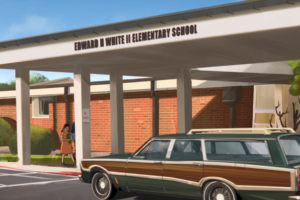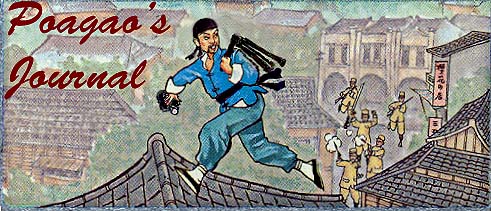Space-age childhood
Recently my friend Sean Lotman tweeted about a Richard Linklater movie he’d seen that he said gave him nostalgia about growing up in the states, so I took a look, expecting a generic childhood in some random American town, but when the flick started:
“The time is spring, 1969,” the narrator, voiced by Jack Black, says at the beginning of Apollo 10 1/2. “The place is Ed White Elementary School in El Lago, Texas.”
I went to Ed White Elementary in the late 70s/early 80s. We lived in El Lago for six years. Damn.
 So I’m just going to go through the film and comment on what stood out for me. From the start, it’s interesting what they got exactly right and what seemed off. The sound of the kickball game is exactly right, but their depiction of the school doesn’t look quite right. I know it was supposed to be 1969 and I only started there in 1976 or so, but still, it doesn’t look like they had any actual alumni on staff, and the school’s been added to over the years. It was from that kickball court that I watched the first space shuttle fly on the back of a 747 over the school, possibly while I was wearing my puffy silver astronaut’s jacket, complete with patches, but I never had any aspirations in that direction. They did get the big fields next to the school right, but the hallways had windows at the top that don’t show up in the movie. I remember being so frustrated that I kicked my bright red plastic lunch box into those walls so hard that it broke into pieces. I also remember the beatings that the film passes off as just the way things were then. To me, Texas was a different world from Florida where we’d lived prior to that. Toxic masculinity permeated the entire society. From what I read on the news, it still does.
So I’m just going to go through the film and comment on what stood out for me. From the start, it’s interesting what they got exactly right and what seemed off. The sound of the kickball game is exactly right, but their depiction of the school doesn’t look quite right. I know it was supposed to be 1969 and I only started there in 1976 or so, but still, it doesn’t look like they had any actual alumni on staff, and the school’s been added to over the years. It was from that kickball court that I watched the first space shuttle fly on the back of a 747 over the school, possibly while I was wearing my puffy silver astronaut’s jacket, complete with patches, but I never had any aspirations in that direction. They did get the big fields next to the school right, but the hallways had windows at the top that don’t show up in the movie. I remember being so frustrated that I kicked my bright red plastic lunch box into those walls so hard that it broke into pieces. I also remember the beatings that the film passes off as just the way things were then. To me, Texas was a different world from Florida where we’d lived prior to that. Toxic masculinity permeated the entire society. From what I read on the news, it still does.
The houses of El Lago look different in the film too, smaller, simpler, with simpler, smaller yards. That doesn’t seem like it would have been too hard to research…you can go on Google Maps and look at them to know what they look like; they’re still there. Ours was built in 1960, like most of them, but the movie claims everything was being built in the late 60’s, which I don’t think was the case. It said there were no trees in 1969, but if that was the case the large trees we had everywhere grew very quickly in only seven years. We even had treehouses. Perhaps Linklater grew up in Houston, but I don’t think he grew up in El Lago.
I do remember the Astrodome games and the electronic sign. The interior decor of the film’s family’s house looks a bit too modern, too stereotypically 60’s. I can’t say whether our decor was in step with the times, but it seems to me from seeing other people’s houses that our Ethan Allen standard wasn’t too far from the norm. We certainly did have that coiled rug though; I spent many an evening and Saturday morning lying on that thing watching our big Zenith.
I remember the occasional flooding; to this day I get nostalgic about walking on grass with a few inches of water over it. The U-tote’M, yeah I remember that place where I spent my allowance on Mad Magazines and Hubba Bubba bubble gum. I also remember the rocket in the playground. I think one of them is still there actually, according to Google Maps. The TV shows and cartoons seem largely the same, though the ones we saw were largely already in syndication by the 70’s. These kids, though, they were allowed to stay up til midnight? How?
I remember “sewage park”, though we never called it that. It was just a field by the plant; we had to ride our bikes through the fenced-in bottleneck between the two to get to and from school without going miles out of the way. You can see it here, complete with some kid riding their bike towards the bottleneck after school. Substitute that red bike for a black Huffy Bandit and it could have been me. It was, alas, a great spot for bullies to ambush kids, which I managed to avoid until my last day of 5th grade, when I was attacked and all my stuff from my elementary school career trashed and strewn around that damn field. In fact, there was plenty of trauma during those years.
I don’t recall the fumigation trucks, and certainly nobody thought it would be cool to ride bikes behind those things. As for “Big bike adventures”, I would explore the woods nearby, finding an old cemetary that I now realize probably should have been a protected historic site, and unwisely hid in a storm drain in the rain. It’s all condos now.
I remember the Baskin-Robbins (damn, it’s still there too?), but not the bowling alley or arcades. Then again I didn’t really have many friends, got into too many fights, and my brother and sister were too much older to want to have much to do with a little kid like me, so I was alone a lot of the time. We did have that same stereo cabinet to play records, and I had a small radio to listen to music to make things seem ok late at night. We never had parties either; perhaps my parents also didn’t really have friends, or, as they both worked and were raising three kids, they were just too tired.
Astroworld I remember going to but not much else other than that it was across from the Astrodome. I have much better memories of concerts in the park and at Jones Hall. Our station wagon was a 1973 Pinto Squire, baby blue with fake wood trim, but the family car was a 1969 Buick Electra 225, gold and white two-tone. We called it Burt, or at least my sister did, as she was a fan of Burt Reynolds at the time.
Then again, the film Apollo 10 1/2 is about the summer of 1969, and things were different by the time I came along. I missed the moon landing, and by the time we were living in El Lago moon missions had stopped, Vietnam was over, and indeed the whole culture was undergoing huge changes. We left in 1981.
It’s nice that Linklater is nostalgic for his childhood, but it was apparently very different from mine. The film, while light-hearted and interesting, just brought back too many ghosts, and I kind of wish he’d picked somewhere else.


 The ceremony was a little embarrassing. No fewer than three dance shows were held, one with several bored-looking girls and one excited-looking but rather erratic girl, one pseudo-Arabic dance, and a hip-hop dance show during which the MC didn’t shut up about the dancer’s background until halfway through. Then the awards started.
The ceremony was a little embarrassing. No fewer than three dance shows were held, one with several bored-looking girls and one excited-looking but rather erratic girl, one pseudo-Arabic dance, and a hip-hop dance show during which the MC didn’t shut up about the dancer’s background until halfway through. Then the awards started.







